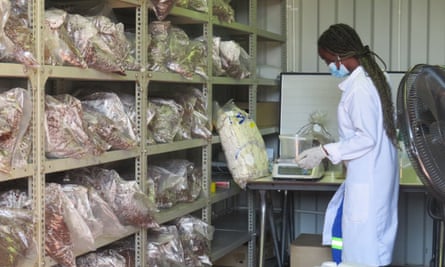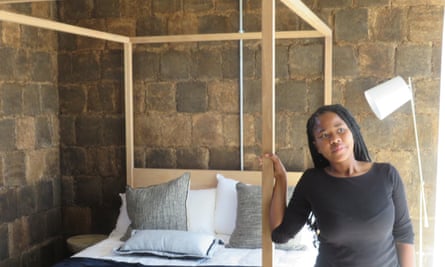“People think the house would smell because the blocks are made of all-natural products, but it doesn’t smell,” says Kristine Haukongo. “Sometimes, there is a small touch of wood, but otherwise it’s completely odourless.”
Haukongo is the senior cultivator at the research group MycoHab and her job is pretty unusual. She grows oyster mushrooms on chopped-down invasive weeds before the waste is turned into large, solid brown slabs – mycoblocks – that will be used, it’s hoped, to build Namibian homes.
“We wanted a new, better way to curtail the housing crisis and a sustainable way to curb the negative effects of the encroacher bush on our environment,” said Magreth Mengo, the head of brand and marketing at Namibia’s Standard Bank. The bank worked with MycoHab – when it was affiliated with the Massachusetts Institute of Technology, the architecture firm Redhouse Studio and the Shack Dwellers Federation of Namibia (SDFN) – to find a sustainable way to deal with several issues. “This project is a first of its kind and is still very much in the experimental phase but shows a lot of promise,” said Mengo.
Namibia, with a population of about 2.7 million, urgently needs at least half a million new homes to address its severe housing shortage. Nearly 90% of households earn less than N$2,700 ($144.69) a month, according to 2016 figures, and can’t afford a home. One in five people live in makeshift homes made out of waste materials or zinc sheets.

The woody, wiry encroacher bushes occupy 45m hectares (111m acres) of Namibia’s land – pushing out grass and other vegetation. The plants are slowly creeping into Namibia’s agricultural regions and affect groundwater recharge in a country where rainfall is precious.
The Namibian government plans to burn 300m tonnes of encroacher bush every 15 years to mitigate its environmental impacts and produce charcoal for profit, but this is increasing the country’s carbon dioxide emissions.
“Traditionally encroacher bushes in Namibia are harvested and used for charcoal and wood production, hence there is a huge release of carbon emissions,” said Tulimo Uushona, an environmentalist.
The MycoHab project decided to take a different approach. Rather than burning the bushes, MycoHab grinds them up and uses them as a substrate on which to grow gourmet oyster mushrooms. When fully grown, the mushrooms are sold to local retailers and the leftover waste is compressed and baked into building materials called mycoblocks, with each slab being made from about 10kg of bush.
“If this technology becomes widespread, we could mitigate much of the more than 300m tonnes of bush the government of Namibia wants to thin,” said Haukongo. “In a normal mushroom farm, the substrate is thrown out or used as compost, but here we turn them into mycoblocks.”

Concrete is believed to be responsible for 4 to 8% of the world’s CO2, emitting almost 1kg of CO2 equivalent per 1kg. MycoHab estimates that mycelium blocks store 0.8kg of CO2 equivalent per 1kg of materials produced. And because these slabs come from waste resources, the homes built using mycoblocks are “more cost-effective” and would require “less labour”, said Haukongo.
“While these blocks are heavier when compared to standard bricks, they can be erected faster, resulting in lower construction costs. To build a small house for one family, over 12 tonnes of bush would be needed,” she said.
This is not the first time fungi has been used as a building material. In 2014 an experimental building called the Hy-Fy in Queens, New York, was made out of crop waste and mycelium and architects and researchers have been investigating the possibilities of this material ever since.
after newsletter promotion
In February this year, MycoHab opened its first mycelium-based home to the public, but the startup is struggling with scaling its operations to cover housing needs in Namibia. “We would love to see MycoHab inspire the architecture and building industries to develop more regenerative design,” said Haukongo. “MycoHab helps regenerate Namibia’s grasslands, mitigates greenhouse gas emissions, and provides food and housing – all from waste materials.”
Heinrich Amushila, the co-director of the SDFN, loves the blocks but said cost would be an issue. “The bricks are fireproof and environmentally friendly, but the initiative is still working on buy-ins from aspiring homeowners to further fund the venture. This can pose a challenge, as prices would be relatively similar to concrete homes, because, although cheaper to make, transporting Mycoblocks to the housing location is still expensive.”
Amushila said his organisation helps subsidise the elevated prices by involving candidates in the process of brickmaking as well as in the construction of the houses.

Romeo Muyunda, a spokesperson for the Namibian ministry of environment, forestry and tourism, welcomed the efforts aimed at preserving the environment.
“We are happy that such initiatives are being made by Namibians,” he said. “This being a private initiative, however, I must encourage them to make sure they are compliant with the Environmental Management Act.”
This article is published in collaboration with Egab.
Source: theguardian.com


